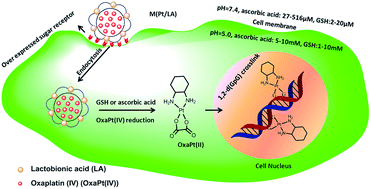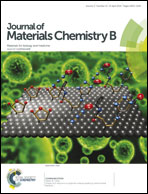Lactose targeting oxaliplatin prodrug loaded micelles for more effective chemotherapy of hepatocellular carcinoma†
Abstract
A sugar active targeting system for the platinum(IV) prodrug [oxaliplatin(IV)–COOH or in short form OxaPt(IV)] of clinically relevant oxaliplatin (OxaPt(II)) has been reported here for the first time. To achieve this, a series of hydrophilic biocompatible polyurethanes containing free pair-wised pendant amino groups (PU) were synthesized and then lactobionic acid (LA) was grafted to the polyurethane as a targeting moiety, in order to prepare PU–LA conjugates. Thereafter, the prodrug, OxaPt(IV) was introduced into the PU–LA conjugates resulting in the formation of polyurethane platinum(IV) conjugates (PU–LA/Pt) with targeting LA groups. Similarly, PU–Pt conjugates without the LA targeting groups were also prepared. These conjugates were self-assembled into micelles [non-targeting micelles: M(PU–Pt) and targeting micelles: M(PU–LA/Pt)] in water. An in vitro study demonstrated that, compared with M(PU–Pt), M(PU–LA/Pt) demonstrated a lower IC50 (79 μM vs. 126 μM) at 72 h and greater cellular uptake of drugs in HepG2 cells. An in vivo study revealed that M(PU–Pt) and M(PU–LA/Pt) displayed much higher blood drug concentrations and bioavailabilities than the free drug, OxaPt(IV). Moreover, M(PU–LA/Pt) showed enriched distribution in the liver and xenograft H22 tumors as well as better antitumor efficacy. M(PU–LA/Pt) may be a promising polymeric prodrug of the widely used OxaPt(II) for the clinical treatment of various liver cancers.


 Please wait while we load your content...
Please wait while we load your content...